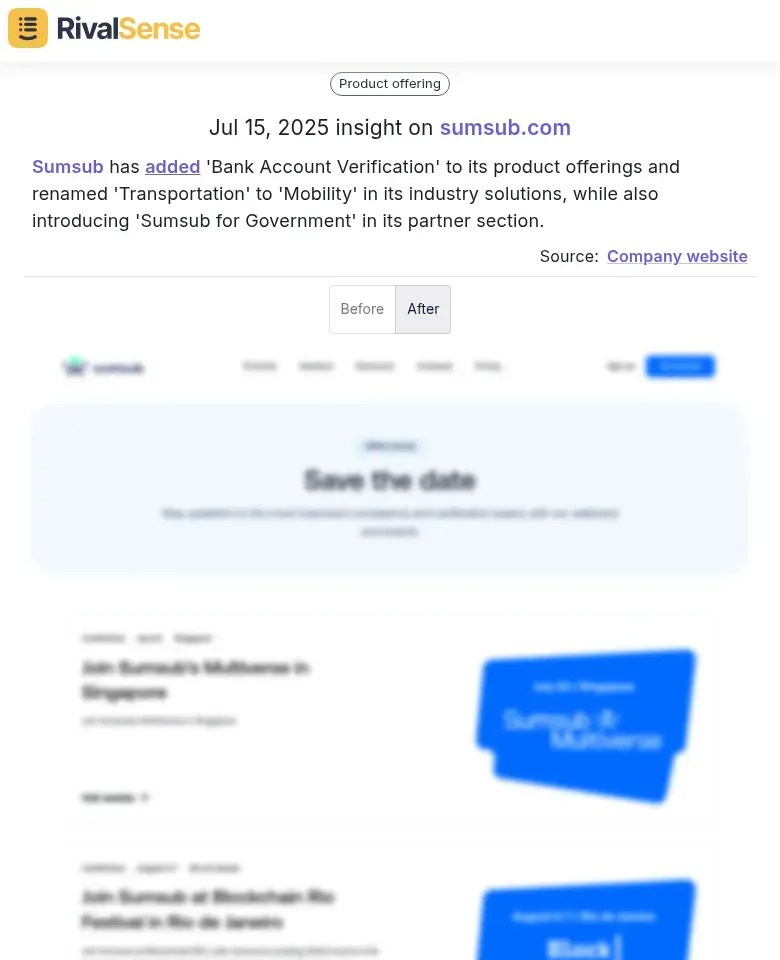How Sumsub's Expansion Spurred Rival's Strategic Shift
Before Sumsub's expansion, the identity verification sector featured stable dynamics with dominant players like Jumio, Onfido, and Trulioo leading regional niches. These companies maintained strongholds through specialized solutions—financial services integrations, AI-driven authentication, and global verification capabilities—with innovation focused on accuracy rather than aggressive market expansion.
Key players sustained positions via deep platform integrations and strategic partnerships. For example, Jumio prioritized real-time ID verification while Onfido leveraged AI for document checks. This environment created predictable competitive boundaries, with rivals concentrating efforts on three core strategies:
- Enhancing Core Offerings 🛠️: Investing in AI/ML to accelerate verification and reduce errors.
- Regional Focus 🌏: Strengthening APAC and LATAM market presence.
- Partnerships 🤝: Collaborating with fintechs and regulators for compliance.
Practical Advice for Business Leaders:
- Audit your unique strengths quarterly to reinforce differentiation.
- Monitor emerging players that could disrupt your positioning.
- Leverage customer feedback loops to refine product-market fit.
This equilibrium set the stage for seismic shifts when Sumsub initiated its growth surge.
Sumsub's Expansion: A Game-Changer in the Industry
Sumsub's strategic expansion fundamentally disrupted market dynamics through geographic diversification and product innovation. By embedding local compliance requirements into its platform, Sumsub achieved unprecedented global scalability—transitioning from a niche player to an industry benchmark almost overnight. This move not only captured new market segments but also pressured competitors to accelerate their own innovation cycles.
The ripple effects were immediate: rivals pivoted toward specialized niches or fast-tracked R&D pipelines. For instance, several competitors abandoned broad-market approaches to focus on verticals like healthcare or crypto compliance. Key takeaways for executives include:
✅ Localization First: Adapt solutions to regional regulations before expanding.
✅ Customer-Centric Agility: Use client feedback to drive rapid iterations.
✅ Preemptive Monitoring: Track competitor expansions to anticipate market gaps.
📋 Checklist for Expansion Readiness:
- Conduct regulatory landscape analysis
- Validate product-market fit in test regions
- Develop contingency plans for competitor counter-moves
The Rival's Strategic Shift: A Response to Sumsub's Growth
Sumsub's aggressive growth directly threatened rivals' customer retention and market positioning. Initial challenges included diluted differentiation and client attrition, forcing one major competitor to overhaul its strategy across three fronts: product innovation, experience enhancement, and targeted marketing.
The rival countered Sumsub's moves by launching AI-powered verification features absent in Sumsub's suite, streamlining onboarding workflows, and executing geo-specific campaigns highlighting these advantages. This 12-month transformation followed a phased rollout:
| Timeline | Strategic Milestone | Business Impact |
|---|---|---|
| Month 3 | AI verification launch | Technical differentiation |
| Month 6 | Customer portal redesign | 40% support ticket reduction |
| Month 12 | Regional marketing blitz | 15% market share recovery |
Actionable Steps for Threatened Businesses:
- Run SWOT analyses quarterly to identify vulnerabilities.
- Prioritize quick CX wins (e.g., 24/7 support) to rebuild trust.
- Allocate 20% of R&D budget to competitor gap-filling features.
Analyzing the Outcomes of the Strategic Shift
The rival's strategic pivot yielded mixed short-term results but solidified long-term resilience. Early market share losses occurred as clients tested Sumsub's new offerings, yet within 18 months, the refocus on niche verification services drove 22% higher retention in core segments like banking. Stakeholder confidence rebounded as metrics stabilized, proving the value of decisive adaptation.
Comparative performance data reveals critical insights:
| Metric | Pre-Shift | Post-Shift |
|---|---|---|
| Customer Acquisition Cost | +18% YoY | -12% YoY |
| Enterprise Retention | 73% | 89% |
| Market Reach | 12 verticals | 8 (deepened focus) |
Execution Framework for Strategic Pivots:
- 📊 Benchmark against competitors pre-pivot
- 💬 Secure stakeholder alignment via impact projections
- 🔍 Monitor sentiment through pilot-phase NPS surveys
- 📈 Track CAC/LTV ratios weekly
- 🎯 Reallocate resources quarterly based on performance
Lessons Learned: Competitor Tracking as Strategic Leverage
Proactive competitor intelligence transforms market threats into opportunities, as demonstrated by Sumsub's rivals. Real-time tracking of product launches, category changes, and partnership shifts enables businesses to anticipate disruptions and refine counter-strategies. For instance, RivalSense recently detected that Sumsub added 'Bank Account Verification' to its product suite, rebranded 'Transportation' to 'Mobility' solutions, and launched a 'Sumsub for Government' partnership program—revealing their focus on financial and public-sector expansion.

Why this matters: Such insights allow you to:
- 🎯 Identify whitespace opportunities (e.g., bank verification gaps)
- 🔄 Adjust messaging to counter new competitor positioning
- ⏱️ Time feature launches to disrupt rival announcements
Best Practices for Continuous Monitoring:
- Set automated alerts for competitor website/social changes
- Cross-reference pricing updates with customer churn data
- Share intelligence across product, sales, and marketing teams weekly
Conclusion: The Future of Competitive Strategy
The Sumsub case proves that sustained market leadership requires anticipatory strategy, not reactive tactics. As verification markets fragment into hyper-specialized niches, agility will separate industry leaders from laggards. Future-ready approaches include quarterly "competitive war games" to stress-test responses and embedded monitoring in strategic planning.
3 Predictions for B2B Leaders:
- AI-driven competitive intelligence will become table stakes for CXOs
- Winners will leverage real-time data to launch "precision counter-offensives"
- Partnerships will emerge as primary growth accelerators
Turn insights into action: Try RivalSense Free to receive your first automated competitor report today. Track product launches, pricing shifts, and partnership moves—before they impact your market position.
📚 Read more
👉 B2B Competitive Research: Internet Insights Workflow Breakdown
👉 Comparative Market Share Analysis: B2B Auto Dealerships
👉 Competitor Partnerships & Clients Cheat Sheet: Essential Insights
👉 How homechoice's Bold Promo Shift Reveals Competitive Pressure in Retail
👉 Competitor Response Prediction Methods: Stay Ahead in the Game
